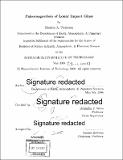Paleomagnetism of Lonar impact glass
Author(s)
Pedersen, Shelsea A. (Shelsea Anne)
DownloadFull printable version (7.194Mb)
Other Contributors
Massachusetts Institute of Technology. Department of Earth, Atmospheric, and Planetary Sciences.
Advisor
Bejamin P. Weiss.
Terms of use
Metadata
Show full item recordAbstract
Several dozen impact glasses from Lonar Crater, in Maharashtra, India, were analyzed for evidence of impact-generated paleofields, and possible motional remanent magnetization. Lonar Crater formed when a meteorite impacted a bed of Deccan Trap basalts. Upon impact, the basalt was super heated into a fluid melt that would have been ejected from the crater, moving at speeds that allowed the smaller pieces of basalt to cool in mid-air. These smaller pieces would have cooled instantaneously, and due to their ferromagnetic composition may have recorded the presence of an impact generated magnetic field. This paper focuses on analyzing several dozen basaltic glass samples from the perimeter of Lonar Crater that are considered to be some of the most plausible known terrestrial analogs to the lunar impact glasses. Lonar impact glasses could serve as a decent analogue to lunar tektites, although differences in their rotational NRM and grain size suggest that they may not be the best recorders of paleointensity. The impact glasses display clear evidence of a series of wild, directionally unstable magnetic moments when heated to temperatures in excess of 400 to 500°C that are not observed in other terrestrial samples. The simplest explanation for this unusual behavior is that these randomized magnetic moments are the result of the progessive removal of different magnetization moments that had, up until the higher temperatures, been blocked in. Upon their removal, these randomized high temperature moments were revealed. Based on the NRM/sIRM ratios of the splash-form spherules the glasses slightly underestimate the intensity of the field in which they cooled. This underestimate is in part possibly due to the effects of rotation during cooling. Their unique motional remanent magnetization is quite fascinating, but may be detrimental to the spherules' ability to retain a strong enough NRM, preventing them from displaying evidence of an impact-generated paleofield at Lonar Crater.
Description
Thesis: S.B., Massachusetts Institute of Technology, Department of Earth, Atmospheric, and Planetary Sciences, 2008. Cataloged from PDF version of thesis. Includes bibliographical references (pages 65-68).
Date issued
2008Department
Massachusetts Institute of Technology. Department of Earth, Atmospheric, and Planetary SciencesPublisher
Massachusetts Institute of Technology
Keywords
Earth, Atmospheric, and Planetary Sciences.